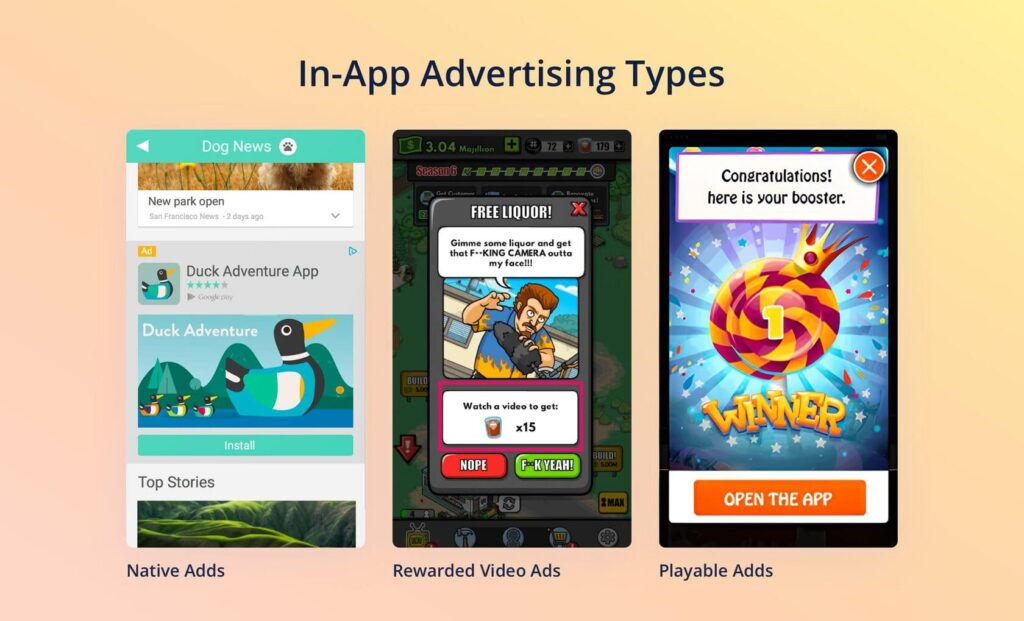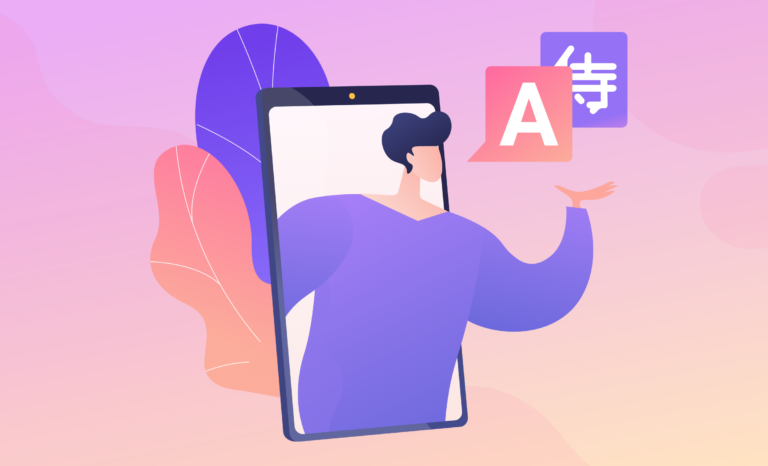You’ve probably heard that mobile usage is in the constant process of skyrocketing which, in its turn, makes the potential perks of effective in app advertising trends worth delving into.
Limitless Internet access and widespread mobile device usage are what drive the ever-dynamic growth of the In-App Advertising (IAA) niche. In 2021, for instance, the global IAA scene generated nearly $200 billion. This number has grown even bigger this year. Moreover, by 2027, researchers expect the market to reach a whopping $350 billion.
Naturally, these numbers attract a lot of marketing specialists. Well-executed IAA can effectively drive your revenue, that’s a fact. Therefore, with some of the best practices under your belt, you are bound to take your brand awareness and app engagement to the next level.
What exactly does the notion of IAA entail? How do in-app ads work, in a nutshell? What is their classification, and what is it based upon? How do you effectively assess the results of your campaigns? And, what is more important, what are the best strategies to employ for your ultimate marketing success? In this piece, you’ll find the answers to these and some other questions on the topic. Now let’s get straight to the core of this post and let you in on how to market an app like a pro with IAA.
Table of Contents
What Is In App Advertising?
It’s an efficient and incredibly profitable monetization model for mobile brands where they display ads via their apps for compensation. These days, in app advertising examples have long switched from tiny irritating banners to vibrant, attention-grabbing, and overall enchanting vids. It’s a surefire marketing tool for both brands and agencies.
A solid in app advertising strategy allows publishers to keep creating free-of-charge content while bolstering their revenue along the way. Keep reading for details on how it all works.
How In App Advertising Works
Prior to covering the basics of how it all functions, here are the main parties involved in your in-app marketing campaign:
- advertisers: they are responsible for creating ads, crafting a campaign, and then rolling it out;
- app publishers: they do the tech part by choosing and setting up the best-suiting mobile ad network for the job;
- ad network: the bridge between the advertisers and the publishers, ensuring that the right ads are served;
- mediation solutions: they aid devs in boosting their in-app ads revenue by linking them to a treasure trove of ad networks.
Now, let’s touch upon the how-it-works part. It all starts when the requested-by-the-user’s-smartphone ad starts moving through the mediation solution. After that, it moves to the ad network and pinpoints the most profitable ad for that user.
An array of criteria are taken into consideration at this stage. From there, the ad becomes visible within the mobile app in real-time. Ad networks are capable of marketing an app to an exceptionally wide target audience and thus generate top-notch traffic in the long run.
Why a Solid In App Advertising Strategy Is Crucial
Did you know that mobile spending almost reached $300 billion last year? That’s a yummy piece of the pie everyone wants to bite into these days. Plentiful opportunities await developers that employ in app advertising best practices and thus benefit from this ever-increasing mobile ad spend trend.
Wondering about the perks of the best in app advertising strategies? Here are the major ones:
- Increase in revenue;
- Boosted user experience;
- Multiplied in-app purchases;
- Enhanced user engagement.
Succeeding in IAA is no bed of roses and requires some investment, both time- and finance-wise. It does make you face such challenges as overcoming the immense competition and measuring your ad’s true performance. However, learning how to advertise in apps is still worth all the effort.
Types of In-App Ads
The IAA classification is exceptionally diverse and impactful. The specifics of ad types that exist on the scene are based on the purpose they serve to increase your brand awareness and thus bolster your revenue. Find the main IAA types below:
- Classic Rectangular Banners: Practical In-App Display Advertising
These text’n’pic-style static suckers are pretty common and well-recognizable. They are also inexpensive, a breeze to set up, and supported across all devices. - Video Ads: Perfect for App Campaigns for Engagement
Vids are all the rage on the digital scene these days. This type of IAA is highly attention-grabbing, engaging, and fun. A quick tip: One and the same video will annoy your audience, so make sure you approach using this format with some versatility in mind. Also, the video shouldn’t be too long: 20 secs max. - Outstream Vids: Unintrusive Newbies
Created expressly for smartphones and tablets, this format is fairly new. You can see these vids when scrolling through non-video in-app content e.g., textual blog posts and the like.
The vid starts automatically playing as you scroll over it. If you click the ad, the sound will play, too. Upon scrolling down such a vid, it resumes playing. With that said, this type of IAA is exceptionally unintrusive. - Interstitials: Memorable Yet (Potentially) Annoying
Served in a slightly intrusive full-screen mode in-between your game levels, this IAA type is sure to grab your attention. These ads are usually highly immersive and exciting. However, you never asked them to open. You cannot close some of them until they end. All this adds up to their slight intrusivity.

- Pre-Roll Vids: Great for Successful Mobile App Marketing Campaigns
These bite-sized up-to-15-secs video ads are shown right before you access in-app content. With these masterpieces of modern IAA art, you get the chance to focus purely on your relevant target audience’s interests (read as instantly turn leads into loyal customers). - Native Ads: Promotion in Disguise
Native ads excel in imitating regular content, blending perfectly well into the overall look and feel of the application while grabbing your target consumers’ attention. In other words, users don’t usually realize it’s an ad when they click on it. For this particular reason, conversion for these suckers is impressively high. - Rewarded Video Ads: Positive Reinforcement Is Everything
These ads mostly show up as you play your favorite mobile games. This IAA type encourages you to watch it until the end in exchange for a highly anticipated reward e.g., new tools, bonuses, power-ups, or virtual money. That’s what we call effective positive reinforcement! - Playable Ads: Popular In-Game Teasers
These ads allow you to play the game for a certain period of time to motivate you to get the full version of the game. It’s eye-catching, immersive, and tempting, especially if the game is good. To maximize the effect, incorporate a good call-to-action and ensure the whole thing doesn’t last longer than 60 secs.

Tips for Successful IAA
Learning how to put ads in your app the right way is an exciting and long-term process. The theory is important, but it all comes down to practice in the long run. Here are a few quick hacks to take into consideration before you get the practicing going:
- Experiment with various ad formats, pricing models, and ad networks This will aid you in pinpointing the most effective strategies for your product revenue-wise.
- Follow consumer privacy regulations religiously Monitor this issue on a regular basis and adjust your approach accordingly. Ensuring your product perfectly complies with these rules should be among your top priorities.
- Make those creatives shine You have up to two seconds to catch your potential consumer’s attention before they leave for good. Therefore, work on eye-capturing creatives that are guaranteed to stir up everyone’s fancy and skyrocket engagement to stardom.
- Avoid over-stuffing your app with ads Segment your target consumers like a pro. Split them into those who have made a purchase and those who haven’t. Display ads to the non-paying audience and once they purchase your product, adjust the messaging accordingly.
- Know your audience As a matter of fact, this step is paramount for connecting with your users in the most effective way. Understand who they are and what they want. Then adjust your ads accordingly. It might sound simple, but it does come with a bit of a learning curve.
- Gather feedback App-monitoring tools can give you vital insight into your consumers. However, it’s not enough if your intention is to get under your target audience’s skin in the most positive sense ever. Therefore, create pathways allowing your consumers to provide you with feedback about your application. At the end of the day, it will tremendously aid you in polishing your IAA strategies.
- Analyze non-stop Monitoring your user engagement is sure to enhance the effectiveness of your campaigns. Compare your IAA strategies to other marketing models you’ve tried and evaluate the results. Learn from your mistakes and refine your approach 24/7.
- Stay within your budget IAA can be costly, especially if you’re a beginner marketer with little experience. Determine your budget and invest wisely if you don’t want to break the bank with no particular outcome. Adjust your strategies to how much you’re ready to invest in your endeavors.
How to get advertisers for your app is also an important topic. We’ll eagerly dwell upon it in detail in one of our next posts, so make sure you add our platform to your favorites for further updates.
Conclusion: Experiment, Analyze, Repeat
App monetization via IAA is a great idea, especially on the freemium-dominated scene. Success in this niche is always about pinpointing the crucial balance throughout an array of various factors. Keep a laser-like focus on finding the mobile advertising network that matches your app, consumers, and ad type you’ll go with. As you progress through your IAA experience, you will experiment with ad types a lot.
Analyzing your IAA strategy results, delivering informative insights, and assessing your revenue flow dynamics are crucial in terms of getting to grips with how successful your campaigns are. Therefore, you need to equip yourself with a solid app monitoring solution and a reliable ASO intelligence tool if you want to lay your hands on up-to-date analytical data and performance stats.
You’ll need to learn how to measure the viewability of your in-app ads because your investments will pay off only when the ads are viewed by real people (and not by bots). All these must-dos might feel a bit overwhelming. Don’t let this discourage you, though. These tasks are definitely worth coping with, for they’ll help you master the art of IAA, get a few steps closer to the ultimate success, and earn some serious money along the way.




